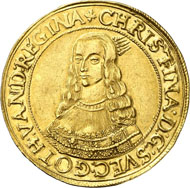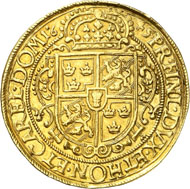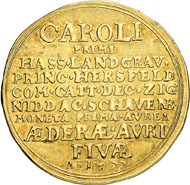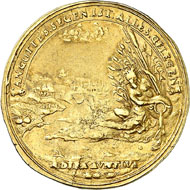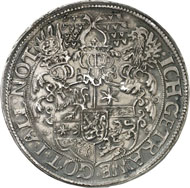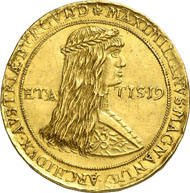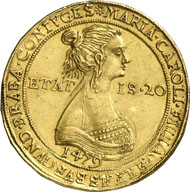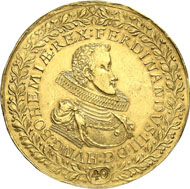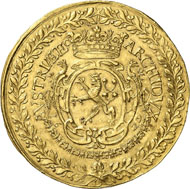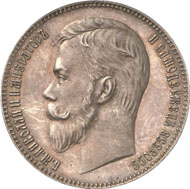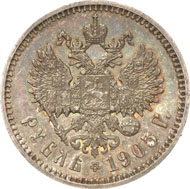29-10-2012 – 30-10-2012
Rarities Auctions No. 219-222
A Coronation Coin Crowns Künker’s Rarities Auctions with a Hammer price of 360,000 EUR
Künker certainly capped off the 2012 auction year on a brilliant high note – realizing a total of 12.3 million EUR in hammer prices on October 30th and 31st, a good 76 % more than the overall estimate expected for the four catalogues. Only 18 lots remained for post-auction sale out of a total of 2152. The largest part of the auctions’ success can, without a doubt, be attributed to catalogue 219, which featured the fourth (and final) part of the collection of Swede Julius Hagander. The 377 numbers in the collection outperformed their estimates by an average of 111 %, totaling roughly 1.7 million EUR in sales. There was just one item left over from this first catalogue of the two auction days. The other 17 remaining items belonged to the fourth catalogue (No. 222), Russian rarities. The other 573 numbers (out of 590) in this catalogue proved to be such a success though that they also substantially eclipsed their overall estimate – by 102%, no less – bringing in a total of more than 1.38 million EUR. The three hundred Hessian rarities featured in the second catalogue (No. 220) certainly held their own as well, bringing in 2.5 million EUR instead of the estimated 1.4, a surplus of roughly 55 percent. In the third catalogue (No. 221), additional parts of the collection of Hamburg estate agent Vogel changed hands; all 885 lots were sold. What’s more, hammer prices totaled almost 7 million EUR, about 72 % more than the overall expected estimate of 4 million.
With that brief general overview out of the way, it’s time to take a closer look at just what was on offer. Let’s start off with the carefully selected and generously equipped “Sweden and Its Possessions” catalogue – a true bibliophilic pleasure, which Fritz Rudolf Künker (in collaboration with Ulf Nordlind) placed on the bookshelf for collectors. The sheer quality of the collection and rarity of the exhibits were certainly deserving of the extensive illustrations and detailed texts. As Hammer prices go, it would seem that Christina ultimately proved most popular:
No. 7053: SWEDEN. Christina (1632-1654). 10 ducats 1645. Ahlström 30 (XR, this specimen, under Erfurt); Fb. 926 (“Very rare”, under Erfurt). Hagander 198. Neumann -. Sixth known specimen, third known privately-owned specimen, fine gold patina, very fine to extremely fine. Estimate: 30,000 EUR. Hammer price: 120,000 EUR.
The sharp-nosed, large-eyed queen brought in 110,000 and 120,000 EUR, respectively, for her 1644 and 1645 10-ducat-pieces from the Riga Mint both estimated at the significantly lower 30,000 EUR. Both pieces exist in extremely few known specimens. German cities under Swedish rule also minted coins, and here, for example, we have a triple ducat from Augsburg from 1632 that sold for 22,000 EUR (Estimate: 15,000), an Erfurt imperial thaler from 1634 that sold for 20,000 EUR (Estimate: 5,000 EUR) and 3-ducats from Hildesheim from 1631 that sold for 44,000 EUR (Estimate: 20,000 EUR). As with so many of the Hagander items, each is the sole privately owned specimen.
No. 7589: HESSE-KASSEL. Charles (1670-1730). 2 gold gulden 1677 (edergold). Fb. 1271 (“Unique”). Kirchheimer 63. Schütz 1247. Unicum, very fine. Estimate: 100,000 EUR. Hammer price: 100,000 EUR.
Up next was the catalogue of Hessian rarities. The truly unique 1677 double edergold gulden of Landgrave Charles was estimated at 100,000 EUR and fetched – amazingly – 100,000 EUR! The second known specimen of Charles’ 1687 imperial thaler was estimated at 30,000 EUR and sold for 55,000 EUR. Although the Landgraviate of Hesse-Marburg is extremely manageable by numismatic standards, having only existed from 1567 to 1604, it nevertheless had a sizeable showing here by way of 13 large silver coins.
No. 7522: HESSE-MARBURG. Louis IV, “the Elder.” (1567-1604). Thick double imperial thaler 1595. Dav. 9292. Schütz 512. Second known specimen, sharply struck with dark patina, extremely fine. Estimate: 30,000 EUR. Hammer price: 75,000 EUR.
The true showstopper, though, was the 1595 thick double imperial thaler of the first (as well as last) Regent, Landgrave Louis IV, which sold for the tidy sum of 75,000 EUR (Estimate: 30,000 EUR). The broad triple imperial thaler from 1629 of the landgrave William V brought in double its estimate of 30,000 EUR, selling for 60,000 EUR. The 1765 silver medal of Louis VIII of Darmstadt of the stag hunt at Dianaburg performed much as expected, selling for 5,500 EUR (Estimate: 5,000 EUR). An interesting bit of information, however, lends this piece a certain air of superiority – the prized stag that was killed was a legendary 32-ender that’s still talked about today. A 1776 star thaler from Kassel, often referred to as a “blood dollar” in American collectors’ circles, brought in six times its 1000 EUR estimate. Why “blood dollar” you may ask? The answer lies in the fact that Landgrave Frederick II had hired out soldiers to England who were then deployed in the fight against the North American colonies’ struggle for freedom.
The first parts of the extensive Vogel Collection were liquidated by Künker in December 2011 and June 2012. On offer this time were parts three and four, “Gold rarities” and “Coins and Medals from Hamburg.” The pieces on offer, according to one observer “blew everything else out of the water.” Take, for example, two gold medals in the weight of 7 ducats, which a hapless aspirant at the medallist office of the Hall Mint had had privately made in an effort to impress his prospective employer, Archduke Charles. The first piece, an imitation of the first guldiner, climbed all the way from 80,000 to 140,000 EUR …
No. 8038: HOLY ROMAN EMPIRE. Maximilian I. (1490-1519). 7 ducats undated (posthumous stamping around 1563). Egg S. 44. Fb. 13 a (“Very rare”). M./T. S. 41. Moeser/Dworschak, Archduke Sigismund, S. 98. Second known specimen, extremely fine. Estimate: 25,000 EUR. Hammer price: 180,000 EUR.
… while the second, a restrike of the famous wedding coin of Maximilian with Maria of Burgundy went from 25,000 to a very impressive 180,000 EUR. A unicum – a twelvefold, undated ducat (around 1525) of Ferdinand I weighing over 40 grams – far surpassed its estimate of 25,000 EUR to sell for 130,000.
No. 8051: HOLY ROMAN EMPIRE. Ferdinand III, 1625-1637-1657. 40 ducats 1629, Prague. Dietiker -. Doneb. – (cf. 2353, there in silver). Fb. 45 (“Rare”). Halacka -. Herinek 83 (there, Glatz Mint). Slg. Horsky – (cf. 1965, there as 100 ducats). Likely the sole remaining specimen in trade, extremely fine. Estimate: 150,000 EUR. Hammer price: 360,000 EUR.
The absolute pinnacle of the two days in Osnabrück, however, was a nearly 140 gram gold piece of 40 ducats minted in Prague in 1629 in honour of the Bohemian coronation of Ferdinand III. It’s presumably the last remaining specimen in trade. The extremely fine piece was being offered in the catalogue at 150,000 EUR, but sold instead for the staggering hammer price of 360,000 EUR! A unique 20-fold 1628 ducat of the Saxon Johan Georg I was estimated at 50,000 EUR, but went instead for 140,000 EUR. The wealthy, opulent Hanseatic city’s history is really reflected in its gold coins, as illustrated by these two examples: a gold trial strike of 8 ducats from the stamps of the 32-schilling piece from 1808 was knocked down at 40,000 EUR (Estimate: 20,000 EUR) and a double bank doubloon of 20 ducats from 1665 went for 65,000 EUR (Estimate: 20,000 EUR).
Russia has become a strong area of collection in recent years, and if the results of the Osnabrück October auctions are any indication, its appeal shows no signs of abating. Russian coins and medals once again ran the gamut from copper to silver to gold, but we can unfortunately highlight just a few examples here (the rest are available online). A 1729 ruble of Czar Peter I, estimated at 1,500 EUR, went for the much higher 16,000 EUR …
No. 9484: RUSSIA. Nicholas II (1894-1917). Ruble 1905. Bitkin 59 (R1). Dav. 293. Very rare year in outstanding condition, lovely patina, PP, min. touched. Estimate: 7,500 EUR. Hammer price: 48,000 EUR.
… and a 1905 ruble from Nicholas II made an impressive climb from an estimate of just 7,500 to a hammer-price of 48,000 EUR. The price realized for a 25-ruble piece (2 1/2 Imperial) from 1908 of the last Czar turned out to be much as expected given its status: Estimate: 80,000 EUR, Hammer price: 145,000 EUR.
You will find comprehensive result lists on the website of the auction house Künker.





